SAP Asset Analytics
Filter By
Browse By
- SAP Analytics and AI
- SAP Application Development and Integration
- All SAP Application Development and Integration
- SAP ABAP
- SAP ABAP Development Tools
- SAP ABAP Test Cockpit
- SAP API Management
- SAP BAPI
- SAP Basis
- SAP BRF
- SAP Business Application Studio
- SAP CMS
- SAP Design Studio
- SAP Development Tools
- SAP DevOps
- SAP EAI
- SAP EDI
- SAP Extension Suite
- SAP Fiori
- SAP Fiori Elements
- SAP Integration Suite
- SAP Low Code Application Development
- SAP Low Code Automation
- SAP Netweaver
- SAP Release Management
- SAP UI5
- SAP Web Application Server
- SAP Web IDE
- SAP Business Process Management
- SAP Center of Excellence
- SAP CIO
- SAP Customer Experience
- SAP Data and Data Management
- All SAP Data and Data Management
- SAP BW
- SAP BW/4HANA
- SAP Crystal Reports
- SAP Data Archiving
- SAP Data Center
- SAP Data Governance
- SAP Data Integration
- SAP Data Migration
- SAP Data Quality
- SAP Data Services
- SAP Data Strategy
- SAP Data Visualization
- SAP Data Warehouse Cloud
- SAP DMS
- SAP Document Control
- SAP EIM
- SAP ETL
- SAP ETL Tools
- SAP HANA
- SAP HANA Administration
- SAP HANA Deployment Infrastructure
- SAP HANA Studio
- SAP Master Data
- SAP Master Data Governance
- SAP MDM
- SAP Enterprise Architect
- SAP Enterprise Asset Management
- SAP ERP
- SAP Finance
- All SAP Finance
- SAP Accounting
- SAP AR AP
- SAP Asset Accounting
- SAP Billing Systems
- SAP BPC
- SAP BRIM
- SAP Cash Management
- SAP Central Finance
- SAP Controlling
- SAP COPA
- SAP Cost Center Accounting
- SAP Currency Risk
- SAP e-invoicing
- SAP FICO
- SAP Finance Automation
- SAP Advanced Financial Closing
- SAP Financial Consolidation
- SAP Financial Planning
- SAP FX Risk
- SAP General Ledger
- SAP Global Tax Management
- SAP Hyperion
- SAP Order to Cash
- SAP Payment Processing
- SAP Profitability Analysis
- SAP Rebate Management
- SAP S/4HANA Finance
- SAP SWIFT Compliance
- SAP Treasury Management
- SAP Universal Journal
- SAP Governance Risk and Compliance
- SAP Human Capital Management
- SAP Intelligent Technologies
- SAP Platform and Technology
- All SAP Platform and Technology
- SAP Business Technology Platform
- SAP Cloud
- SAP Cloud Connector
- SAP Cloud Integration Platform
- SAP Cloud Migration
- SAP Cloud Platform
- SAP Cloud Providers
- SAP Cloud Strategy
- SAP Digital Signature
- SAP Container Platform
- SAP HANA Enterprise Cloud
- SAP Digital Asset Management
- SAP Smart Forms
- SAP HEC
- SAP Digital Integration Hub
- SAP Hyperscalers
- SAP Infrastructure
- SAP Messaging
- SAP Quality and Testing
- SAP Security
- SAP Spend Management
- SAP Supply Chain Management
- All SAP Supply Chain Management
- SAP APO
- SAP Asset Management
- SAP Business Network
- SAP Digital Manufacturing Cloud
- SAP Digital Twin
- SAP EWM
- SAP IBP
- SAP Inventory Management
- SAP Label Printing
- SAP Logistics
- SAP Manufacturing
- SAP Manufacturing Automation
- SAP MES
- SAP MII
- SAP MM
- SAP MRO
- SAP MRP
- SAP Order Management
- SAP Plant Maintenance
- SAP PLM
- SAP Production Planning
- SAP S&OP
- SAP SD
- SAP SPM
- SAP Supply Chain Planning
- SAP Track and Trace
- SAP Transportation Management
- SAP System Administration
Predictive Asset Analytics is the use of statistical modeling, data mining techniques, machine learning, and digital twin technologies to make predictions about future outcomes. A cloud deployment or cloud native solution is required to gain insights from sensor data and engineering simulations. With advances in data storage and loT sensor technology organizations can learn about each asset’s individual performance to predict asset productivity.
Improving reliability, performance, and safety are top priorities for organizations today. But organizations are also focusing on controlling costs and maximizing value from existing investments by supporting predictive maintenance and service. Predictive asset analytics is a solution for end-to-end asset management to provide early warning signals and give a diagnosis of equipment long before failure.
Key Capabilities of SAP Predictive Asset Insights include:
- A 360 view of assets: A holistic view of the asset model with a single predictive tool increasing visibility into master, transactional, performance, and loT data sensor data.
- Intuitive and scalable machine learning: Ability to detect abnormalities and predict failure without data scientist intervention, extending the intelligence of predictive maintenance by machine learning capabilities.
- Advanced analytics: Gain insights into failure modes and leading indicators by benefiting from purpose-made analytical capabilities augmented with predictive asset intelligence.
- Digital twin simulations: Apply ANSYS digital twin technology to analyze assets in action and over time in a live environment where engineering simulations support virtual sensors.
Predictive Asset Analytics is the use of statistical modeling, data mining techniques, machine learning, and digital twin technologies to make predictions about future outcomes. A cloud deployment or cloud native solution is required to gain insights from sensor data and engineering simulations. With advances in data storage and loT sensor technology organizations can learn about each asset’s individual performance to predict asset productivity.
Improving reliability, performance, and safety are top priorities for organizations today. But organizations are also focusing on controlling costs and maximizing value from existing investments by supporting predictive maintenance and service. Predictive asset analytics is a solution for end-to-end asset management to provide early warning signals and give a diagnosis of equipment long before failure.
Key Capabilities of SAP Predictive Asset Insights include:
- A 360 view of assets: A holistic view of the asset model with a single predictive tool increasing visibility into master, transactional, performance, and loT data sensor data.
- Intuitive and scalable machine learning: Ability to detect abnormalities and predict failure without data scientist intervention, extending the intelligence of predictive maintenance by machine learning capabilities.
- Advanced analytics: Gain insights into failure modes and leading indicators by benefiting from purpose-made analytical capabilities augmented with predictive asset intelligence.
- Digital twin simulations: Apply ANSYS digital twin technology to analyze assets in action and over time in a live environment where engineering simulations support virtual sensors.
Benefits of SAP Predictive Asset Insights are:
- Improves service effectiveness
- Lowers maintenance costs
- Increases asset availability
Vendors partners for predictive asset analytics are: SAP , PWC, KCT
Key Considerations for SAPinsiders are:
- Advanced Analytics and Performance Intelligence. In the recent state of the market for process automation, SAPinsiders indicated that intelligent automation and process intelligence are key capabilities they are planning to build in the next two years. This analyst insight explores some critical aspects to be aware of on your path to develop these capabilities.
- Achieve Business Clarity with Process Intelligence. Process intelligence provides an understanding of where process deficiencies exist and where leverage opportunities reside. SAPinsider sat down with Shoeb Javed, Chief Strategy and Product Officer for software testing firm Worksoft Inc., to discuss the latest Achieve Business Clarity with Process Intelligence process intelligence trends.
- Digital twins are on the Rise to Mitigate Risk. Companies are searching for greater efficiencies to improve operational efficiencies and be more resilient. In this analyst insight learn what digital twins are, how they work, how they have evolved, and benefits that they can bring to your organization. Optimization is where digital twins excel to test contingency plans and build resilience.
860 results
-

- SAP ECC 6.0
 Premium
Premium
How to Comply with the Provisions of IFRS while Recording Capital Asset Transactions in SAP ECC 6.0
Reading time: 25 mins
Learn key adjustments that are required to make capital asset management compliant with International Financial Reporting Standards (IFRS). See the changes you need to make in SAP ERP Central Component (SAP ECC) 6.0 while transitioning from US Generally Accepted Accounting Principles (GAAP). Key Concept An organization needs to make adjustments in accounting for financial transactions...…
-

 Premium
Premium
Inflation-Based Revaluation of Fixed Assets
Reading time: 23 mins
Learn the configuration done for monthly inflation-based revaluation. This configuration needs slight changes based on the frequency and inflation calculation methodology required for a specific implementation. Key Concept Inflation-based revaluation is a statutory requirement for several high-inflation countries. These countries publish an inflation index for revaluation of the fixed asset base of the company. In...…
-

 Premium
Premium
AUC with Investment Measure Using Work Breakdown Structure
Reading time: 20 mins
FinancialsLearn how to implement assets under construction (AUC) with the Investment Management module using work breakdown structure (WBS). Follow a detailed discussion of the settlement process. Key Concept A work breakdown structure (WBS) element with its assets under construction (AUCs) can be termed as an investment measure. In simple terms, an AUC is created to...…
-
-

- SAP Enterprise Asset Management
 Premium
Premium
Achieving Effective and Efficient Asset Management
Reading time: 11 mins
In heavy asset intensive industries from manufacturing and processing facilities through to Rail, Aerospace, Utilities, Oil & Gas and Mining operations, the largest operational expense beyond the CAPEX of building the plant resides in maintaining the equipment required to do the job. Membership Required You must be a member to access this content.View Membership LevelsAlready…
-

- SAP BI Tools
 Premium
Premium
An Introduction to SAP Predictive Analytics 2.0 and SAP HANA Predictive Tools
Reading time: 64 mins
In this exclusive report by Hillary Bliss, take a walk into the world of the SAP suite of predictive tools with an in-depth tour of the new SAP Predictive Analytics 2.0 and how it ties into SAP HANA and SAP Lumira. Learn the importance of general predictive modeling concepts, and then apply those concepts as...…
-

 Premium
Premium
How to Set Up and Process Leased Assets
Reading time: 11 mins
Learn how to configure leased assets to make sure that not only depreciation is posted but also the interest and the periodic payments. Key Concept In SAP Asset Accounting (FI–AA) you can maintain several kinds of assets. One particular kind is the leased asset. Besides the standard fixed-asset functionality for this kind of asset, the...…
-

- SAP ERP
 Premium
Premium
Create Multiple Assets with Individual Characteristics in One Step
Reading time: 7 mins
Learn how to customize the functionality required to simultaneously create multiple assets and still be able to maintain specific data for each individual asset. Key Concept Within Asset Accounting (FI-AA), you can create one asset at a time or multiple assets simultaneously. Since the release of R/3 4.0A, SAP supports simultaneous creation of multiple assets....…
-
-

 Premium
Premium
3 Ways to Ensure Accurate Depreciation Values in ECC
Reading time: 12 mins
The primary focus of the Asset Accounting (FI-AA) sub-ledger is to accurately calculate and track values for fixed asset records. Often it is possible that planned values stored in FI-AA do not reflect the existing system configuration and therefore are incorrect. You can use program RAAFAR00 (recalculate values) to ensure that calculated amounts are correct....…
-

- SAP Accounting
 Premium
Premium
SAP S/4HANA Finance: Understand the Different Options and Nuances of Enabling Parallel Accounting in New Asset Accounting
Reading time: 24 mins
Learn about the configuration options available in SAP S/4HANA Finance to set up parallel accounting aligned to different accounting principles, especially when you are migrating from classic Asset Accounting (FI-AA), a parallel accounts approach, to the new FI-AA module. Key Concept The SAP S/4HANA Finance system provides a transparent, real-time, optimized IT solution for implementation...…
-

 Premium
Premium
How SAP ERP Combats the Challenges of Global Accounting and Financial Reporting Standards
Reading time: 16 mins
Review some SAP ERP solutions, functionalities, and capabilities that you can use to meet the challenges of specific International Financial Reporting Standards (IFRS) and International Accounting Standards (IAS) requirements, including ones that cover revenue, accounting policies, operating segments, and more. Key Concept International Accounting Standards (IAS) and International Financial Reporting Standards (IFRS) guide global financial...…
Become a Member
Unlimited access to thousands of resources for SAP-specific expertise that can only be found here.
Become a Partner
Access exclusive SAP insights, expert marketing strategies, and high-value services including research reports, webinars, and buyers' guides, all designed to boost your campaign ROI by up to 50% within the SAP ecosystem.
Upcoming Events
Related Vendors
Your request has been successfully sent


